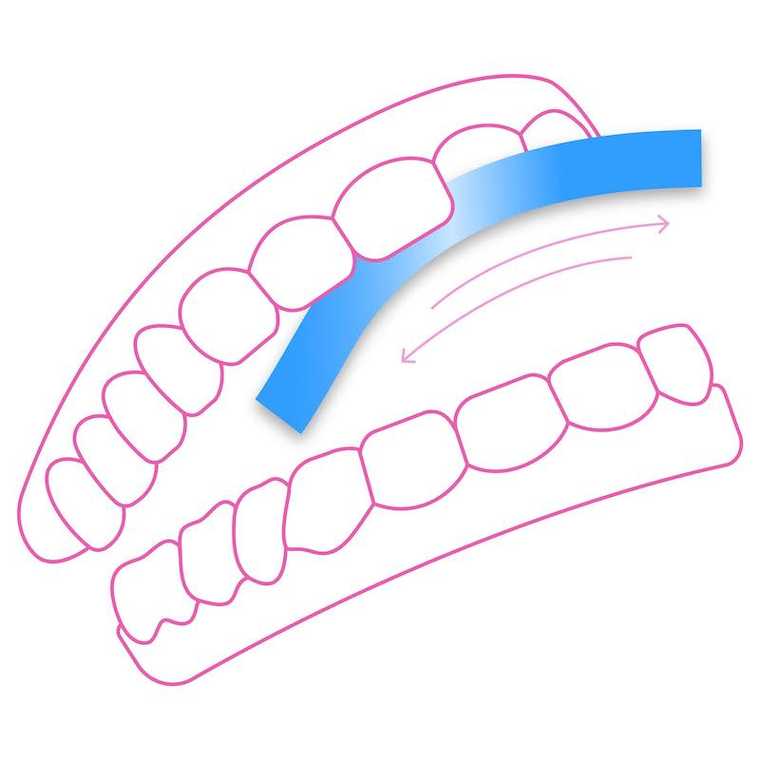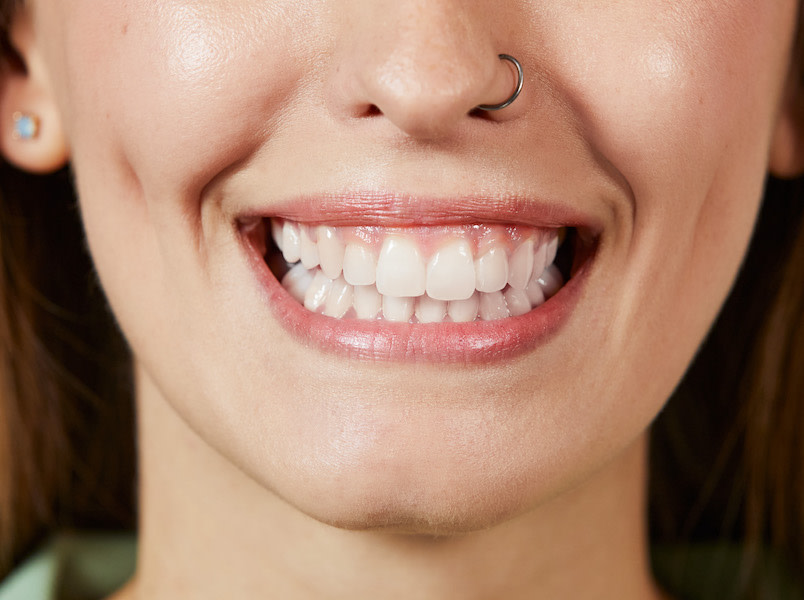IPR: Room for your confident smile
Interproximal enamel reduction (IPR) creates room for you to move your teeth and produce a confident smile.



What is an IPR?
Originally, the term IPR referred to a natural process: The wearing down of dental enamel by chewing. Since we mainly eat soft foods nowadays, natural IPR is almost a thing of the past. In order to give the teeth enough room to move naturally, dentists now perform an IPR manually and gently remove excess dental enamel.
What is the exact procedure for an IPR?
An IPR appointment lasts 45 minutes at most and is usually completely pain-free.
1. Preparation
If the patient so desires, a local anesthetic can be given at the start of the treatment.
2. Abrasion
With diamond abrasives, the enamel is reduced at the required sites to the desired thickness (by 25% at most).
3. Follow-up
The affected sites are polished, sealed and remineralized with deep fluoride. If the gums are pinching, a local painkiller can be applied.
4. Please note
Patients should not drink for 30 minutes or eat for an hour after the procedure. This allows the deep fluoride to work properly.
When is an IPR recommended?
An IPR creates room for visually attractive and medically appropriate positioning of the teeth. An IPR is performed as part of an aligner treatment when the teeth don't have enough room to move to the desired position. In a crowded mouth a much better result can often be achieved with an IPR.
Independently of an aligner treatment, an IPR is performed when the teeth are so crowded that they are pressing each other out of the jaw. An IPR can positively affect the positioning and preservation of the teeth in the jawbone (instead of falling out in extreme cases). It can also help prevent periodontitis.
![[CRO] Woman - Looking front - Man - Side eye - Smiles - Hand in shoulder - Yellow - Gradient - Background - Desktop](https://images.ctfassets.net/5fjjg8tiriqf/ECot8VtAM14ZY8Nm5MjtQ/ed8258e6a35c387f951003505824eb1b/2024-05-24-DR-SMILE-EVOLUTION_06_Beauty_Sanny_Morgane_1845_riccardo_retouched__1_.jpg?w=800&h=534&fl=progressive&q=90&fm=jpg)
The benefits of an IPR
All the benefits of interproximal enamel reduction at a glance.
✓ more room so that your teeth can move properly
✓ secure retention of your teeth in the jawbone (helps prevent periodontitis)
✓ ideal conditions for your dental hygiene
✓ optimal esthetic position for your teeth, no gaps, no crowding
Book an IPR appointment with DR SMILE
Check your treatment plan that we have e-mailed to you to find out whether, and at what stage of your teeth straightening process, an IPR needs to be performed. We can also help you directly in the chat section of the app if your inbox has swallowed the treatment plan.
Please arrange an IPR appointment at your DR SMILE partner practice three or four weeks in advance. Please remember to bring your current aligner pair and your next aligner pair with you to your IPR appointment. An IPR cannot be performed without your aligners.
Example: If your IPR takes place in the week for step 7, please bring the aligner pair for step 7 and the pair for step 8. You can find the step numbers on the aligner bag labels.

Frequently asked questions on IPR
Questions about IPR? We have the answers!
The only difference between IPR (interproximal enamel reduction) and ASR (proximal enamel reduction) is the terminology. In addition to these two terms, there are other common ones:
Stripping
Filing
Wenn in Deinem Behandlungsplan steht, dass eine IPR benötigt wird, bevor Du mit den ersten Alignern beginnst, dann buche Deinen Termin, sobald Du Deine DR SMILE x Impress Box erhalten hast.
Wenn die IPR für einen späteren Zeitpunkt in Deiner Behandlung vorgesehen ist, kannst Du in Deinem Behandlungsplan an der roten Markierung einsehen, wann die IPR erforderlich ist.
Buche Deinen IPR Termin 3 bis 4 Wochen im Voraus. So stellst Du sicher, dass die Behandlung nicht unterbrochen wird.
Die Buchung des Termins ist ganz einfach. Du kannst Deinen Termin auf der Website oder über die App buchen. Wenn du Hilfe benötigst kannst Du Dich auch an den Kundenservice wenden.
Wenn Du Deinen Behandlungsplan von DR SMILE x Impress erhältst, wird darin klar angegeben, ob eine IPR notwendig ist und in welchen Phasen der Behandlung sie durchgeführt werden muss.
No, not all dental corrections require enamel reduction in the spaces between teeth. However, in the case of crowding, black triangles and gaps of different sizes in the upper and lower jaw, the dentist may have to create the necessary space before starting the correction of misaligned teeth. Your DR SMILE alignment plan specifies if and when IPRs are planned for the alignment of your teeth.
Wenn eine IPR-Behandlung als Teil Deiner Behandlung geplant ist, liegt das daran, dass das medizinische Team festgestellt hat, dass das Verfahren notwendig ist, um das erwartete Ergebnis zu erzielen.
In einigen Fällen kann es möglich sein, Deine Aligner-Behandlung ohne IPR zu planen, aber bitte beachte, dass die Ergebnisse anders ausfallen werden als bei einer Aligner-Behandlung mit IPR. Dies bedeutet höchstwahrscheinlich, dass Du nicht das bestmögliche Endergebnis erzielen wirst.
In den meisten Fällen, vor allem bei starkem Engstand, gibt es ohne IPR-Behandlung keinen Platz für die Bewegung Deiner Zähne, so dass die DR SMILE x Impress-Behandlung nicht möglich ist. Eine Fortsetzung der kieferorthopädischen Behandlung ohne die richtigen Voraussetzungen kann Deine Zähne und Dein Biss gefährden und neue Probleme verursachen.
Hast Du Bedenken oder Fragen zu Deiner geplanten IPR? Wir sind Mo-Fr telefonisch (9-16 Uhr) & per Chat (9-18 Uhr) erreichbar.
No, the space created between the teeth will be temporary and will close in the course of aligner therapy. Once the tooth alignment is complete, the space will no longer be visible.
Viele entscheiden sich tatsächlich für eine IPR, um ihre Zahnform aus ästhetischen Gründen zu verändern. Aber keine Sorge, sofern die IPR nicht angewandt wird, um schwarze Dreiecke zwischen den Zähnen zu vermeiden und Deine Zähne auch keine dreieckige Form besitzen, wird sich die Form Deiner Zähne nicht verändern.
When performed correctly, IPR has no negative effects on teeth. Studies have shown that the risk of caries does not increase in teeth subjected to IPR. On the contrary: straighter teeth are easier to clean and therefore have a lower risk of caries than crooked teeth. Research also shows that sensitivity is not increased because the tooth structure removed is so minimal that it does not affect the natural protection of the enamel.
Ja, natürlich! Sie vereinbaren den Termin mit den DR SMILE x Impress Partner-Zahnärzt*innen.
